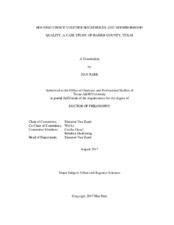| dc.contributor.advisor | Van Zandt, Shannon | |
| dc.contributor.advisor | Li, Wei | |
| dc.creator | Park, Han | |
| dc.date.accessioned | 2018-02-05T21:21:20Z | |
| dc.date.available | 2019-08-01T06:51:20Z | |
| dc.date.created | 2017-08 | |
| dc.date.issued | 2017-07-26 | |
| dc.date.submitted | August 2017 | |
| dc.identifier.uri | https://hdl.handle.net/1969.1/166041 | |
| dc.description.abstract | Affordable housing programs are critical in increasing low-income citizens’ quality of life. The Housing Choice Voucher (HCV) program, one of the major affordable housing programs since 1974, purportedly helps low-income tenants to attain better housing and neighborhood conditions by allowing households to rent units on the private rental market. The greatest advantage of the HCV program is that it offers voucher holders the possibility to choose rental units in their preferred areas. The primary aim of the HCV program is to ensure that subsidized households such as low-income families, senior citizens, and disabled people can reside in decent homes and in neighborhoods with good opportunities, as is the case for general renters.
By adopting a quasi-experimental design, this research assesses locational outcomes for income-qualified households in Harris County, Texas: one of the largest housing markets in the nation. It compares locational outcomes for a list of HCV holders’ addresses to those of a list of households which qualified for HCV but remained on the waiting list. The findings indicate that the HCV program’s Fair Market Rents (FMRs) and Income Limits (ILs) likely restricted HCV households to neighborhoods that are not significantly different from those to which households without vouchers have access. In other words, receiving an HCV subsidy does not notably change the locational outcomes of the recipient households. The comparison analysis between HCV tenants and waitlisted renters shows similar patterns concerning neighborhood-quality levels. This finding stands in contrast to a comparison between the neighborhoods that are accessible to these recipients and those living in units provided by the Low Income Housing Tax Credit (LIHTC) program, as well as those neighborhoods in which average renters live.
This research aims to provide policy recommendations for planners and policy makers in order to guide practical strategies by which to improve the HCV program criteria and thereby help to alleviate current market constraints on HCV residents. | en |
| dc.format.mimetype | application/pdf | |
| dc.language.iso | en | |
| dc.subject | Housing Choice Voucher | en |
| dc.subject | Housing Choice Voucher Waitlist | en |
| dc.subject | Neighborhood Quality | en |
| dc.subject | High-Opportunity Neighborhood | en |
| dc.title | Housing Choice Voucher Households and Neighborhood Quality: A Case Study of Harris County, Texas | en |
| dc.type | Thesis | en |
| thesis.degree.department | Landscape Architecture and Urban Planning | en |
| thesis.degree.discipline | Urban and Regional Sciences | en |
| thesis.degree.grantor | Texas A & M University | en |
| thesis.degree.name | Doctor of Philosophy | en |
| thesis.degree.level | Doctoral | en |
| dc.contributor.committeeMember | Giusti, Cecilia | |
| dc.contributor.committeeMember | Dudensing, Rebekka | |
| dc.type.material | text | en |
| dc.date.updated | 2018-02-05T21:21:21Z | |
| local.embargo.terms | 2019-08-01 | |
| local.etdauthor.orcid | 0000-0002-9103-6628 | |


